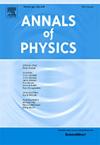Noncommutative black hole in de Rham-Gabadadze-Tolley like massive gravity
IF 3
3区 物理与天体物理
Q2 PHYSICS, MULTIDISCIPLINARY
引用次数: 0
Abstract
We examine the behavior of non-commutative Schwarzschild black holes in the context of massive gravity. According to the investigation, corresponding to a minimal mass, the black hole can have two horizons, one horizon, or no horizon at all. Our results imply the existence of a stable black hole remnant, whose mass can be uniquely calculated in terms of the non-commutative parameter and the graviton mass . Thermodynamic features such as heat capacity and Hawking temperature are studied. We also examine a scalar linear perturbation on the black hole. Quasinormal frequencies are computed via Wentzel–Kramers–Brillouin (WKB) method with Padé improvement. All quasinormal frequencies considered in this work have a negative imaginary part. In the eikonal limit, we investigate the angular velocity and the Lyapunov exponent as a function of . Additionally, we explore the black hole’s shadow across various model parameters. Our findings indicate that non-commutativity leads to a reduction in the black hole’s shadow, with this effect exhibiting a nonlinear relationship. Furthermore, we observe that the inclusion of a massive graviton in the theory results in an increase in the black hole’s shadow radius, particularly at greater observer distances.
de Rham-Gabadadze-Tolley中的非对易黑洞
我们研究了在大质量引力背景下非交换史瓦西黑洞的行为。根据研究,对应于最小质量,黑洞可以有两个视界,一个视界,或者根本没有视界。我们的结果暗示了一个稳定的黑洞残余物的存在,其质量可以用非交换参数θ和引力子质量m唯一地计算出来。我们研究了热容和霍金温度等热力学特征。我们还研究了黑洞上的标量线性扰动。准正态频率的计算采用WKB方法,并进行了pad改进。本文所考虑的所有拟正态频率都有一个负虚部。在斜向极限下,我们研究了角速度和Lyapunov指数作为M/θ的函数。此外,我们通过各种模型参数探索黑洞的阴影。我们的研究结果表明,非交换性导致黑洞阴影的减少,这种影响表现出非线性关系。此外,我们观察到,在理论中包含一个大质量引力子会导致黑洞阴影半径的增加,特别是在更大的观察者距离上。
本文章由计算机程序翻译,如有差异,请以英文原文为准。
求助全文
约1分钟内获得全文
求助全文
来源期刊

Annals of Physics
物理-物理:综合
CiteScore
5.30
自引率
3.30%
发文量
211
审稿时长
47 days
期刊介绍:
Annals of Physics presents original work in all areas of basic theoretic physics research. Ideas are developed and fully explored, and thorough treatment is given to first principles and ultimate applications. Annals of Physics emphasizes clarity and intelligibility in the articles it publishes, thus making them as accessible as possible. Readers familiar with recent developments in the field are provided with sufficient detail and background to follow the arguments and understand their significance.
The Editors of the journal cover all fields of theoretical physics. Articles published in the journal are typically longer than 20 pages.
 求助内容:
求助内容: 应助结果提醒方式:
应助结果提醒方式:


